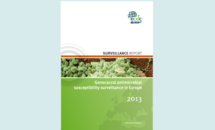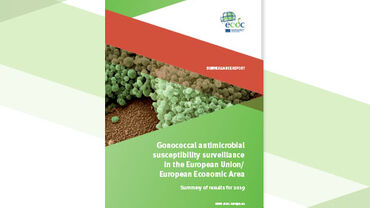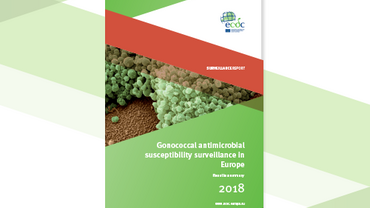Gonococcal antimicrobial susceptibility surveillance in Europe, 2013
During 2013, the European Gonococcal Antimicrobial Surveillance Programme (Euro-GASP) followed the biannual decentralised and centralised testing model used in previous years, requesting participating laboratories to collect gonococcal isolates during two periods (April/May and October/November). Twenty-one countries participated in the gonococcal antimicrobial resistance external quality assessment (EQA) scheme and the EQA continued to show high comparability between participants, raising confidence in the quality and comparability of the gonococcal antimicrobial susceptibility testing in Euro-GASP.
Executive summary
Successful treatment of gonorrhoea, one of the most frequently reported sexually transmitted infections in Europe, requires effective antibiotics. According to a new ECDC report, gonococci across Europe showed slightly higher resistance to the recommended drug for gonorrhoea treatment in 2013.
On an annual basis, countries of the European Union and European Economic Area (EU/EEA) participate in the European Gonococcal Antimicrobial Surveillance Programme (Euro-GASP) to test susceptibility of Neisseria gonorrhoeae to the commonly used antibiotics for gonorrhoea treatment. In 2013, 21 EU/EEA countries collected and tested a total of 1 994 isolates.
The Euro-GASP results for 2013 show that nearly 5% (4.7) of the tested isolates were resistant to one of the main antibiotic agents used for treatment in Europe (cefixime). Compared to 2012 results, when cefixime resistance was observed in only 3.9% of the tested isolates, this does not constitute a significant increase but it reverses the decreasing trend seen in the previous three years. In 2013, 14 countries detected isolates with reduced susceptibility to cefixime, one less than the year before.
The ECDC report Gonococcal antimicrobial susceptibility surveillance in Europe 2013 also indicates that gonorrhoea infections that were less susceptible to cefixime were more likely to be found in female and heterosexual male patients. In addition, resistance to another key antibiotic agent (ceftriaxone) has increased slightly between 2012 and 2013.
Euro-GASP monitors emerging resistance trends
As the control of gonorrhoea depends on effective antimicrobial treatment, even a small increase in drug resistance has a relevant impact due to the risk of treatment failure. Since the European treatment guidelines for gonorrhoea recommend use of two antimicrobials (ceftriaxone or cefixime together with azithromycin), the surveillance of antimicrobial susceptibility of these agents – which is currently undertaken by ECDC’s Euro-GASP – is essential to ensure that patients are successfully treated and the risk of complications are avoided. With around 53 000 reported cases in 2013, gonorrhoea is the second most frequently recorded sexually transmitted infection in Europe after chlamydia.
ECDC launched a regional response plan to control multidrug-resistant gonorrhoea to minimise the threat of drug-resistant gonorrhoea in Europe. This plan argues that countries need to identify and report failures to treatment with currently recommended antimicrobials. At the same time, antimicrobial resistance surveillance should be stepped up to ensure that options for successful treatment of gonorrhoea remain available.
In 2014, 21 countries took part in the gonococcal antimicrobial resistance external quality assessment (EQA). Overall, the participating laboratories performed very well and showed high levels of competence in testing for Neisseria gonorrhoeae strains.
Download

Publication data
Data
Distribution of minimum inhibitory concentration for cefixime in Euro-GASP 2009-13
Gonococcal antimicrobial susceptibility surveillance in Europe 2013 - Distribution of minimum inhibitory concentration for cefixime in Euro-GASP 2009-13
Data
Distribution of minimum inhibitory concentration for ceftriaxone in Euro-GASP 2004-13
Gonococcal antimicrobial susceptibility surveillance in Europe 2013 - Distribution of minimum inhibitory concentration for ceftriaxone in Euro-GASP 2004-13
Data
Overall percentage of resistant Neisseria gonorrhoeae by antimicrobial year Euro-GASP 2004-13
Gonococcal antimicrobial susceptibility surveillance in Europe 2013 - Overall percentage of resistant Neisseria gonorrhoeae by antimicrobial year Euro-GASP 2004-13
Data
Percentage of isolates with azithromycin resistance by gender male sexual orientation Euro-GASP 2009-13
Gonococcal antimicrobial susceptibility surveillance in Europe 2013 - Percentage of isolates with azithromycin resistance by gender male sexual orientation Euro-GASP 2009-13
Data
Percentage of isolates with cefixime resistance by gender male sexual orientation Euro-GASP 2009-13
Gonococcal antimicrobial susceptibility surveillance in Europe 2013 - Percentage of isolates with cefixime resistance by gender male sexual orientation Euro-GASP 2009-13
Data
Percentage of isolates with ciprofloxacin resistance by gender male sexual orientation Euro-GASP 2009-13
Gonococcal antimicrobial susceptibility surveillance in Europe 2013 - Percentage of isolates with ciprofloxacin resistance by gender male sexual orientation Euro-GASP 2009-13
Data
Resistance to cefixime, ciprofloxacin, azithromycin and penicillin G by country Euro-GASP 2013
Gonococcal antimicrobial susceptibility surveillance in Europe 2013 - Resistance to cefixime, ciprofloxacin, azithromycin and penicillin G by country Euro-GASP 2013
Data
Resistance to cefixime, ciprofloxacin, azithromycin and penicillin G by patient characteristics Euro-GASP 2013
Gonococcal antimicrobial susceptibility surveillance in Europe 2013 - Resistance to cefixime, ciprofloxacin, azithromycin and penicillin G by patient characteristics Euro-GASP 2013





